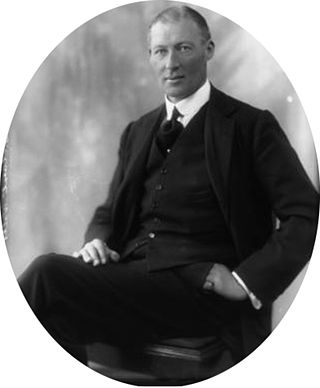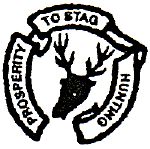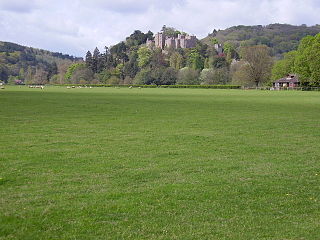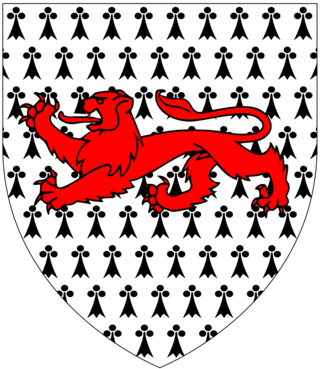Related Research Articles

Dulverton is a town and civil parish in west Somerset, England, near the border with Devon. The town had a population of 1,408 at the 2011 Census. The parish includes the hamlets of Battleton and Ashwick which is located approximately 4 miles (6.4 km) north west of Dulverton.

Colonel Sir Frederick Winn Knight was an English Conservative politician who sat in the House of Commons from 1841 to 1885.

Henry Overton Wills III of Kelston Knoll, near Bath in Somerset, was a prominent and wealthy member of the Bristol tobacco manufacturing family of Wills which founded the firm of W. D. & H. O. Wills. As a philanthropist his best-known act was the funding of the University of Bristol, founded in 1909, of which he became the first Chancellor.
Sir Frederick Wills, 1st Baronet was a businessman, philanthropist and politician in the United Kingdom. He was a director of W. D. & H. O. Wills, a famous tobacco company headquartered in Bristol which later merged into the Imperial Tobacco Company.

Gilbert Alan Hamilton Wills, 1st Baron Dulverton, also known same Sir Gilbert Wills, 2nd Baronet of Northmoor & Manor Heath, was a British businessman and Conservative Member of Parliament from 1909 to 1929.

There have been four baronetcies created for members of the Wills family, owners of W. D. & H. O. Wills and major shareholders and directors of the Imperial Tobacco Company. All four creations were in the Baronetage of the United Kingdom.

Simonsbath is a small village high on Exmoor in the English county of Somerset. It is the principal settlement in the Exmoor civil parish, which is the largest and most sparsely populated civil parish on Exmoor, covering nearly 32 square miles (83 km2) but with a population, at the time of the 2001 census, of 203 in 78 households, reducing to 156 at the 2011 census. The River Exe rises from a valley to the north, and the River Barle runs through the village and is crossed by a triple-arched medieval bridge that was extensively repaired after floods in 1952.

Mordaunt Fenwick Bisset of Bagborough in Somerset, 22nd Scottish feudal baron of Lessendrum in Aberdeen, Scotland, was a British Conservative Party Member of Parliament and a famous west-country Master of Staghounds.

Pixton Park is a country house in the parish of Dulverton, Somerset, England. It is associated with at least three historically significant families, successively by descent: Acland, amongst the largest landowners in the Westcountry; Herbert, politicians and diplomats; and Waugh, writers. The present grade II* listed Georgian mansion house was built circa 1760 by the Acland family and in 1870 was altered by Henry Herbert, 4th Earl of Carnarvon (1831–1890). Although Pixton Park is situated within the manor of Dulverton, the manorial chapel relating to Pixton is situated not at Dulverton but within the Church of St Nicholas, Brushford, across the River Barle, as the lordship of the manor of Dulverton was held from 1568 by the Sydenham family seated at Combe House, on the opposite side of the River Barle to Dulverton and Pixton.

The red deer of Exmoor have been hunted since Norman times, when Exmoor was declared a Royal Forest. Collyns stated the earliest record of a pack of Staghounds on Exmoor was 1598. In 1803, the "North Devon Staghounds" became a subscription pack. In 1824/5 30 couples of hounds, the last of the true staghounds, were sold to a baron in Germany. Today, the Devon and Somerset is one of three staghounds packs in the UK, the others being the Quantock Staghounds and the Tiverton Staghounds. All packs hunt within Devon and Somerset. The Chairman as of 2016 is Tom Yandle, who was previously High Sheriff of Somerset in 1999.

George Wentworth Warwick Bampfylde, 4th Baron Poltimore (1882–1965) of Poltimore and North Molton, Devon, was a peer and major landowner in Devonshire, whose family had been seated at Poltimore from about 1300. He was a Justice of the Peace for Devon and occupied the honorary position of High Steward of South Molton, Devon.

The feudal barony of Dunster was an English feudal barony with its caput at Dunster Castle in Somerset. During the reign of King Henry I (1100–1135) the barony comprised forty knight's fees and was later enlarged. In about 1150 the manors retained in demesne were Dunster, Minehead, Cutcombe, Kilton and Carhampton in Somerset, and Ham in Dorset.

Sharpham is an historic estate in the parish of Ashprington, Devon. The Georgian mansion house, known as Sharpham House, overlooks the River Dart and is a Grade I listed building. The house was commenced in about 1770 by the Royal Navy captain Philemon Pownoll to the designs of the architect Sir Robert Taylor (1714–1788). In the opinion of Nikolaus Pevsner it contains "one of the most spectacular and daring later 18th century staircase designs anywhere in England". The park and gardens are Grade II* listed in the National Register of Historic Parks and Gardens. Part of the descent of Sharpham is shown on the Palmes family heraldic pedigree roll.

Mount Radford is an historic estate in the parish of St Leonards, adjacent to the east side of the City of Exeter in Devon.

Combe is a historic estate in Somerset, England, situated between the town of Dulverton and the village of Brushford.

The Grange is a historic estate in the parish of Broadhembury in Devon, England. The surviving 16th-century mansion house is listed Grade I on the National Heritage List for England.
Tom Yandle of Riphay, Brushford, near Dulverton in Somerset, England, is a farmer and chairman of the Devon and Somerset Staghounds and was High Sheriff of Somerset in 1999 and a committee member of both the National Trust and Exmoor National Park. He played a leading role in challenging both the National Trust's decision to ban stag hunting on the Holnicote Estate and the Labour government's ultimately successful proposal to ban hunting with hounds. The Yandle family was previously resident at nearby Duvale an historic estate in the parish of Bampton, Devon. In 1994 he purchased Northmoor House near Dulverton, and 100 acres of surrounding land, which he later sold.

The Drewe family of Broadhembury are generation owners and inhabitants of The Grange, Sharpham, Broadhembury, Wadhurst Park, Devon, in the west and east of England, from the 16th century to the current date.
The Manor of Heanton Punchardon was a manor in the parish of Heanton Punchardon, Devon, England.
The descent of the Holnicote estate in Somerset, England, is as follows:
References
- ↑ "Exmoor Holiday House Rental for Family Reunions and Celebrations in Somerset". Groupaccommodation.com. Retrieved 2 November 2016.
- ↑ Binding, H. & Bonham-Carter, V., Old Dulverton and Around: Dulverton - Bury - Brushford - Exebridge, 1986, pp.20-23
- 1 2 3 4 5 "Country House in England - Devon - Dulverton - Northmoor House". oneoffplaces.co.uk. Archived from the original on 2 February 2017. Retrieved 2 November 2016.
- 1 2 "Appeal Decision. Northmoor House" (PDF). Exmoor National Park. The Planning Inspectorate. Retrieved 8 November 2016.
- ↑ Punchard
- ↑ Punchard, E.G., Heraldic Scrolls from Grange, Devon Notes & Queries, Vol.3, 1904-5, p.44
- ↑ "Northmoor Chapel Dulverton". Everything Exmoor. Retrieved 11 February 2017.
- ↑ Guinness Book of Records , London, 1966, p.230
- ↑ Debrett's Peerage , 1968, p.381
- ↑ "DODINGTON & COUPER deed | The National Archives". Discovery.nationalarchives.gov.uk. Retrieved 2 November 2016.
- ↑ A history of Northmoor House (nr Dulverton) and the Residents 1859-2006, published in: The Devon Family Historian, Vol.120, Dec 2006; Bonham-Carter, p.22, omits mention of Marriott-Dodington of Northmoor
- ↑ Burke's Genealogical and Heraldic History of the Landed Gentry, 15th Edition, ed. Pirie-Gordon, H., London, 1937, p.626